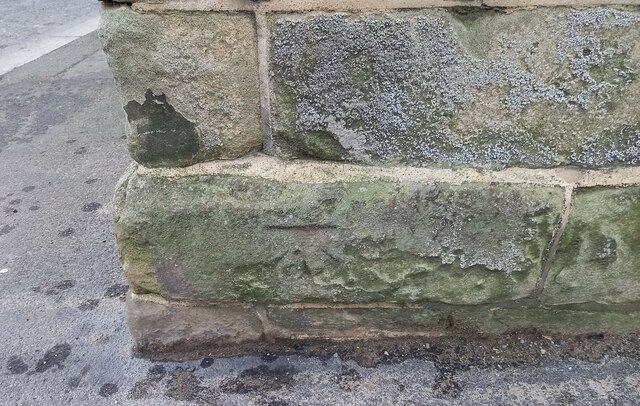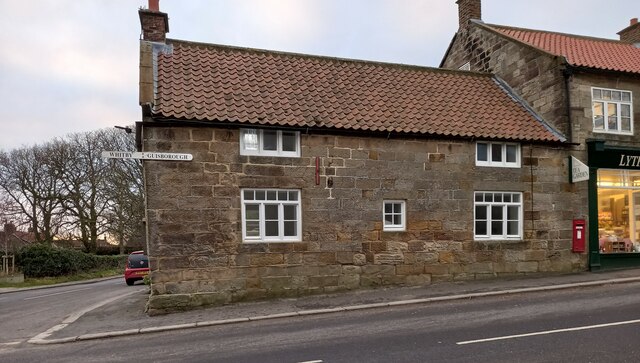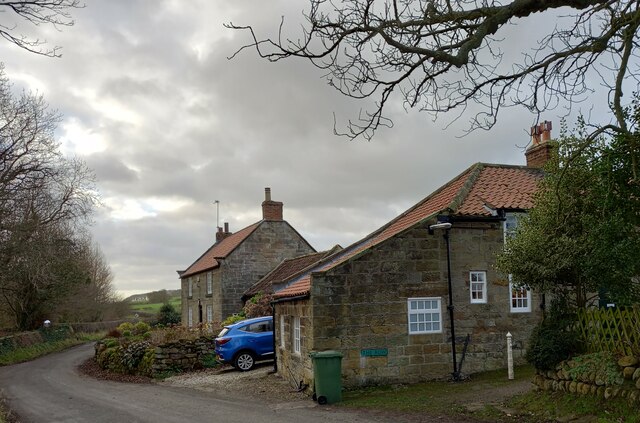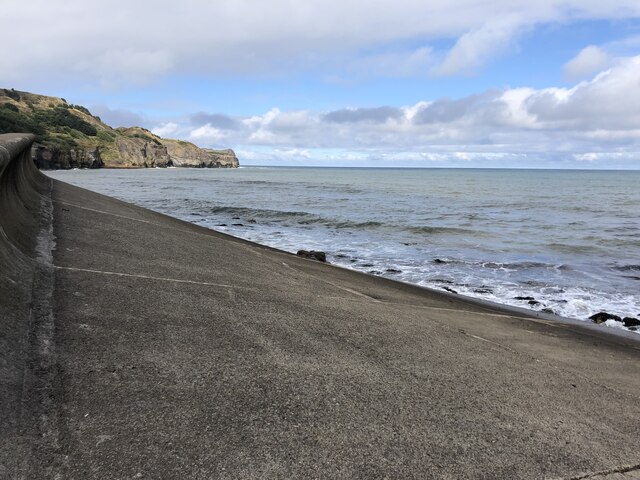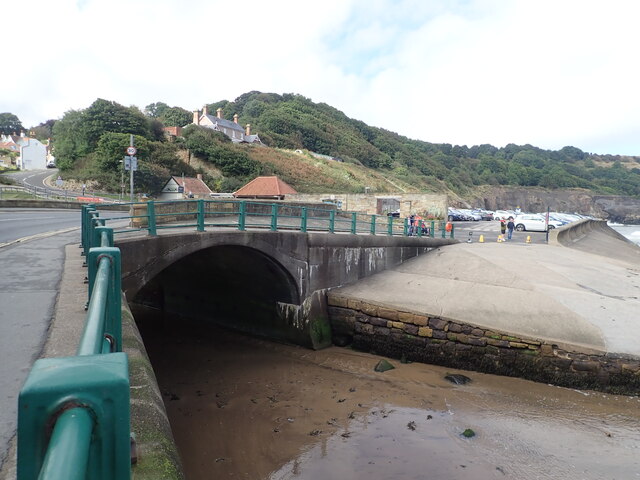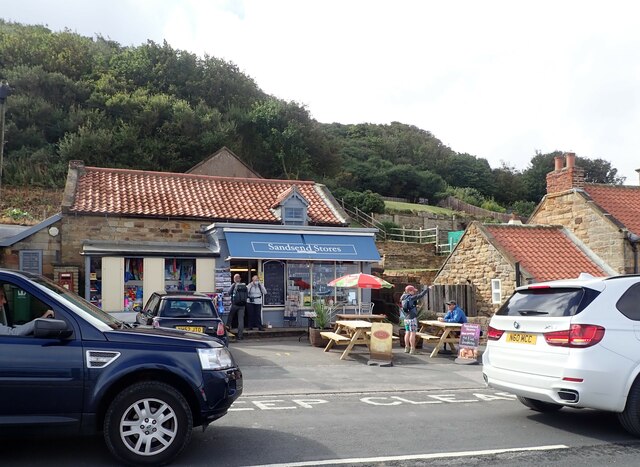Lythe
Settlement in Yorkshire Scarborough
England
Lythe
![Foss Castle: a motte and bailey "The monument includes a motte and bailey castle situated at the head of the valley of the Sandsend Beck, overlooking its precipitous gorge from the north side. The Barnby Beck, major tributary of the Sandsend Beck, issues over a series of waterfalls from a slack, while a minor tributary flows in a steep-sided gully along the western edge of the monument; because of its location the castle has good natural defences on its south-western side. The motte is an artificial mound, 50m in diameter at the base and surrounded by an 8m wide, 2m deep ditch. The mound is 4m high, the flat top being 40m in diameter and partially surrounded by a 0.5m high rampart bank. There are various low earthworks on the top of the mound, some of which will contain the foundations of buildings such as the fortified tower which once stood on the motte while other features are the result of a small-scale excavation reported to have been carried out prior to 1817. To the north-east of the motte and running at a tangent to it is a ditch which links the gully of the small stream to the west with the edge of the precipice to the south; the ditch is 5m wide and 1.5m deep at its north-western end but becomes 10m wide and 3m deep at its south-eastern end. The motte is flanked by two enclosures, or baileys. Of these, the northern one is triangular, measuring 60m by 30m across, bounded by the ditch on its north-eastern side and by the steep, 5m high scarp of the east bank of the stream at the west. The southern bailey is larger, measuring 65m long by 40m wide, bounded by the ditch to the north-east and by the precipice to the south and west. The castle was founded in 1072 by Nigel Fossard and abandoned about 1200 when Robert de Turnham built Old Mulgrave Castle, its stone successor, 700m to the east."
Historicengland.org.uk. (2012). Foss Castle: a motte and bailey, precursor to Old Mulgrave Castle, Lythe - 1008286 | Historic England. [online] Available at: <span class="nowrap"><a title="https://historicengland.org.uk/listing/the-list/list-entry/1008286?section=official-listing" rel="nofollow ugc noopener" href="https://historicengland.org.uk/listing/the-list/list-entry/1008286?section=official-listing">Link</a><img style="margin-left:2px;" alt="External link" title="External link - shift click to open in new window" src="https://s1.geograph.org.uk/img/external.png" width="10" height="10"/></span> [Accessed 11 Dec. 2021].](https://s0.geograph.org.uk/geophotos/07/04/10/7041092_6bc75b57.jpg)
Lythe is a picturesque village located in the county of Yorkshire, England. Situated on the eastern coast, Lythe is part of the North Yorkshire district and lies approximately 7 miles north of the popular seaside town of Whitby. With a population of around 600 residents, the village exudes a charming and tranquil atmosphere.
The landscape surrounding Lythe is breathtaking, with rolling hills and panoramic views of the North Sea. The village itself is nestled on the slopes of Lythe Bank, offering stunning vistas of both the coastline and the nearby North York Moors National Park.
Lythe is steeped in history, with evidence of human settlement dating back to prehistoric times. The village is home to the impressive St Oswald's Church, a Grade II listed building that dates back to the 12th century. Its Norman architecture and intricate stained glass windows make it a must-visit for history enthusiasts.
In addition to its historical attractions, Lythe boasts a vibrant community spirit. The village is home to a range of amenities, including a primary school, a village hall, and a popular local pub. Residents and visitors alike can also enjoy exploring the nearby countryside through a network of footpaths and bridleways that crisscross the area.
Overall, Lythe offers a unique blend of natural beauty, rich history, and a close-knit community, making it an idyllic destination for those seeking a peaceful retreat in the heart of Yorkshire.
If you have any feedback on the listing, please let us know in the comments section below.
Lythe Images
Images are sourced within 2km of 54.504576/-0.6943413 or Grid Reference NZ8412. Thanks to Geograph Open Source API. All images are credited.
![Foss Castle: a motte and bailey &quot;The monument includes a motte and bailey castle situated at the head of the valley of the Sandsend Beck, overlooking its precipitous gorge from the north side. The Barnby Beck, major tributary of the Sandsend Beck, issues over a series of waterfalls from a slack, while a minor tributary flows in a steep-sided gully along the western edge of the monument; because of its location the castle has good natural defences on its south-western side. The motte is an artificial mound, 50m in diameter at the base and surrounded by an 8m wide, 2m deep ditch. The mound is 4m high, the flat top being 40m in diameter and partially surrounded by a 0.5m high rampart bank. There are various low earthworks on the top of the mound, some of which will contain the foundations of buildings such as the fortified tower which once stood on the motte while other features are the result of a small-scale excavation reported to have been carried out prior to 1817. To the north-east of the motte and running at a tangent to it is a ditch which links the gully of the small stream to the west with the edge of the precipice to the south; the ditch is 5m wide and 1.5m deep at its north-western end but becomes 10m wide and 3m deep at its south-eastern end. The motte is flanked by two enclosures, or baileys. Of these, the northern one is triangular, measuring 60m by 30m across, bounded by the ditch on its north-eastern side and by the steep, 5m high scarp of the east bank of the stream at the west. The southern bailey is larger, measuring 65m long by 40m wide, bounded by the ditch to the north-east and by the precipice to the south and west. The castle was founded in 1072 by Nigel Fossard and abandoned about 1200 when Robert de Turnham built Old Mulgrave Castle, its stone successor, 700m to the east.&quot;
Historicengland.org.uk. (2012). Foss Castle: a motte and bailey, precursor to Old Mulgrave Castle, Lythe - 1008286 | Historic England. [online] Available at: <span class="nowrap"><a title="https://historicengland.org.uk/listing/the-list/list-entry/1008286?section=official-listing" rel="nofollow ugc noopener" href="https://historicengland.org.uk/listing/the-list/list-entry/1008286?section=official-listing">Link</a><img style="margin-left:2px;" alt="External link" title="External link - shift click to open in new window" src="https://s1.geograph.org.uk/img/external.png" width="10" height="10"/></span> [Accessed 11 Dec. 2021].](https://s0.geograph.org.uk/geophotos/07/04/10/7041092_6bc75b57.jpg)
![Sandsend Alum Quarries Extract from the Historic England Research Records:
Summary : The remains of three post medieval alum quarries at Sandsend. Alum was principally used in the textile industry as a fixing agent for clothing dyes. It was also used by tanners to produce supple leather. After the shale had been quarried it was then heaped into large mounds, fired and left to smoulder for up to nine months. The shale was then tipped into leaching tanks where it was left to soak in water. The solution, containing aluminium sulphate was then drained off and ran along stone or wooden conduits known as liquor troughs to the alum house. Here the water was boiled away from the solution in evaporating pans. An alkali, derived from human urine or burnt kelp, was added to cause precipitation of the alum crystals. The crystals were then bagged and transported for sale. The burnt shale left in the leaching pits was either disposed of nearby to form enormous shale tips or thrown in to the sea. Quarrying at Sandsend moved from south to north along the coastal cliffs. The earliest quarry was Gaytrees, opened in 1733, followed by Ness End and finally Deep Grove. The quarry probably contains significant archaeological remains of buildings, pits, cisterns and parts of the wooden liquor trough also survive within a rock cut channel. From 1811 to 1933 cementstone was also mined within the quarries. The Middlesborough to Whitby railway was being constructed through the disused alum quarries by 1874.
More information : NZ 859138. Alum quarries at Sandsend Ness in operation from c1613 - 1880. Remains clearly visible. The alum house was on the site of Sandsend station at NZ 860 129 (NZ 81 SE 496).
The monument includes remains of the alum quarries and associated features on the coastal cliffs north of Sandsend. As well as the quarries, the monument also includes structures used for initial processing and transport of the alum. There are three discrete quarries within the monument, extending northwards along the coast for 1km. The earliest quarry, which was working from 1733, was the closest to Sandsend at Gaytrees. The other two, at Ness End and Deep Grove, were excavated later as the extraction progressed along the coast. The quarries were cut into the east and north east-facing coastal cliffs where alum bearing shales were exposed. Once the cliffs were cut back, processing of the alum was carried out on the enlarging quarry floors. The first stage of processing was calcination, remains of which survive as areas of burnt shale, particularly on the sea edge of the central quarry. The next stage was steeping which occurred in stone lined pits, some of which survive throughout the quarry floor. A mid-19th century map shows steeping pits located in the Deep Grove quarry. In the later use of the site the raw liquor thus produced was stored and then sent to the nearby alum house by timber channels known as liquor troughs, part of which survive within a stone tunnel. Remains of other structures such as workshops, offices, stores and a laboratory survive on the quarry floor. Remains of other structures are thought to survive below ground level.
At the northern quarry, Deep Grove, cement stone was also extracted from mines and processed at a mill south of Sandsend. Cement stone was mined from 1811 to 1933 and overlapped the last 50 or so years of alum production. A now disused railway line was built through the length of the monument after the quarries went out of use. This was the Middlesborough to Whitby line which was completed in 1883 and closed in 1958. Embankments, cuttings and supporting walls associated with the railway still survive within the monument.
A number of features are excluded from the scheduling; these are the surface of the old railway line and the trail markers; although the ground beneath these features is included.
The remains of post medieval alum quarry is visible as earthworks on air photographs, centred at NZ 8582 1376.
The remains of three post medieval alum quarries at Sandsend. Alum was principally used in the textile industry as a fixing agent for clothing dyes. It was also used by tanners to produce supple leather. Quarrying at Sandsend moved from south to north along the coastal cliffs. The earliest quarry was Gaytrees, opened in 1733, the next Ness End and the last Deep Grove; Deep Grove closed before 1874. The quarry probably contains significant archaeological remains of buildings, pits, cisterns and parts of the wooden liquor trough also survive within a rock cut channel. From 1811 to 1933 cementstone was also mined within the quarries. The Middlesborough to Whitby railway was being constructed through the disused alum quarries by 1874.
Heritagegateway.org.uk. (2012). Heritage Gateway - Results. [online] Available at: <span class="nowrap"><a title="https://www.heritagegateway.org.uk/Gateway/Results_Single.aspx?uid=1118514&amp;resourceID=19191" rel="nofollow ugc noopener" href="https://www.heritagegateway.org.uk/Gateway/Results_Single.aspx?uid=1118514&amp;resourceID=19191">Link</a><img style="margin-left:2px;" alt="External link" title="External link - shift click to open in new window" src="https://s1.geograph.org.uk/img/external.png" width="10" height="10"/></span> [Accessed 11 Dec. 2021].](https://s1.geograph.org.uk/geophotos/07/04/10/7041097_8cbabcf2.jpg)
![Sandsend Alum Quarries Extract from the Historic England Research Records:
Summary : The remains of three post medieval alum quarries at Sandsend. Alum was principally used in the textile industry as a fixing agent for clothing dyes. It was also used by tanners to produce supple leather. After the shale had been quarried it was then heaped into large mounds, fired and left to smoulder for up to nine months. The shale was then tipped into leaching tanks where it was left to soak in water. The solution, containing aluminium sulphate was then drained off and ran along stone or wooden conduits known as liquor troughs to the alum house. Here the water was boiled away from the solution in evaporating pans. An alkali, derived from human urine or burnt kelp, was added to cause precipitation of the alum crystals. The crystals were then bagged and transported for sale. The burnt shale left in the leaching pits was either disposed of nearby to form enormous shale tips or thrown in to the sea. Quarrying at Sandsend moved from south to north along the coastal cliffs. The earliest quarry was Gaytrees, opened in 1733, followed by Ness End and finally Deep Grove. The quarry probably contains significant archaeological remains of buildings, pits, cisterns and parts of the wooden liquor trough also survive within a rock cut channel. From 1811 to 1933 cementstone was also mined within the quarries. The Middlesborough to Whitby railway was being constructed through the disused alum quarries by 1874.
More information : NZ 859138. Alum quarries at Sandsend Ness in operation from c1613 - 1880. Remains clearly visible. The alum house was on the site of Sandsend station at NZ 860 129 (NZ 81 SE 496).
The monument includes remains of the alum quarries and associated features on the coastal cliffs north of Sandsend. As well as the quarries, the monument also includes structures used for initial processing and transport of the alum. There are three discrete quarries within the monument, extending northwards along the coast for 1km. The earliest quarry, which was working from 1733, was the closest to Sandsend at Gaytrees. The other two, at Ness End and Deep Grove, were excavated later as the extraction progressed along the coast. The quarries were cut into the east and north east-facing coastal cliffs where alum bearing shales were exposed. Once the cliffs were cut back, processing of the alum was carried out on the enlarging quarry floors. The first stage of processing was calcination, remains of which survive as areas of burnt shale, particularly on the sea edge of the central quarry. The next stage was steeping which occurred in stone lined pits, some of which survive throughout the quarry floor. A mid-19th century map shows steeping pits located in the Deep Grove quarry. In the later use of the site the raw liquor thus produced was stored and then sent to the nearby alum house by timber channels known as liquor troughs, part of which survive within a stone tunnel. Remains of other structures such as workshops, offices, stores and a laboratory survive on the quarry floor. Remains of other structures are thought to survive below ground level.
At the northern quarry, Deep Grove, cement stone was also extracted from mines and processed at a mill south of Sandsend. Cement stone was mined from 1811 to 1933 and overlapped the last 50 or so years of alum production. A now disused railway line was built through the length of the monument after the quarries went out of use. This was the Middlesborough to Whitby line which was completed in 1883 and closed in 1958. Embankments, cuttings and supporting walls associated with the railway still survive within the monument.
A number of features are excluded from the scheduling; these are the surface of the old railway line and the trail markers; although the ground beneath these features is included.
The remains of post medieval alum quarry is visible as earthworks on air photographs, centred at NZ 8582 1376.
The remains of three post medieval alum quarries at Sandsend. Alum was principally used in the textile industry as a fixing agent for clothing dyes. It was also used by tanners to produce supple leather. Quarrying at Sandsend moved from south to north along the coastal cliffs. The earliest quarry was Gaytrees, opened in 1733, the next Ness End and the last Deep Grove; Deep Grove closed before 1874. The quarry probably contains significant archaeological remains of buildings, pits, cisterns and parts of the wooden liquor trough also survive within a rock cut channel. From 1811 to 1933 cementstone was also mined within the quarries. The Middlesborough to Whitby railway was being constructed through the disused alum quarries by 1874.
Heritagegateway.org.uk. (2012). Heritage Gateway - Results. [online] Available at: <span class="nowrap"><a title="https://www.heritagegateway.org.uk/Gateway/Results_Single.aspx?uid=1118514&amp;resourceID=19191" rel="nofollow ugc noopener" href="https://www.heritagegateway.org.uk/Gateway/Results_Single.aspx?uid=1118514&amp;resourceID=19191">Link</a><img style="margin-left:2px;" alt="External link" title="External link - shift click to open in new window" src="https://s1.geograph.org.uk/img/external.png" width="10" height="10"/></span> [Accessed 11 Dec. 2021].](https://s2.geograph.org.uk/geophotos/07/04/10/7041098_f25792d3.jpg)
![Sandsend and The Maharajah of Mulgrave Castle In the decade following the death of Maharajah Ranjit Singh in 1839, the Punjab was thrown into turmoil with several successions to the throne and a threat of annexation by the British East India Company.
In 1843, Duleep Singh, just five years old, was crowned King of the Punjab and head of the Sikh nation. He was now extremely rich and ruled under the regency of Ranjit Singh’s youngest widow, Jind Kaur. His wealth included one of the largest diamonds in the world, the Koh-i-Noor, weighing in at 21.12 grms. (105.6 carats).
War with the British East India Company broke out, and, in 1848, the young Singh, now aged ten years old, was forced to sign papers that sacrificed his kingdom and forcing him to resign ‘for himself, his heirs, his successors, all right, title and claim to the sovereignty of the Punjab or to any sovereign power whatsoever, the confiscation of all state property, and the surrender of the Koh-i-Noor diamond’. The Punjab was now British territory.
In return, he was to be given a pension of £40,000 and granted the honour of the title Maharajah (I guess the equivalent to His Royal Highness). He was sent for exile in England where Queen Victoria was apparently quite taken with the young man. She wrote in her diary: ‘Osborne 22 August: A most beautiful morning. We breakfasted in the Alcove with the truly amicable young Maharajah, who is so kind to the children, playing so nicely with them’. I am sure she wasn’t at all influenced by the latest addition to her crown jewels: the Koh-i-Noor diamond.
The Maharajah grew up into the life of an English squire, with a love of shooting, hawking, and other country pursuits and, in 1858, took up residency at Mulgrave Castle which he rented from the Marquis of Normanby, who was serving as British Ambassador in Florence. Queen Victoria was one of the many guests who dined with Singh during his tenure at Mulgrave Castle.
But he wasn’t happy, and frequently clashed with the Government over his financial compensation. His money slowly dwindled, he spent lavishly on his estate at Elveden, Norfolk, which he had brought after vacating Mulgrave in 1862. He made many fruitless attempts to regain the Koh-i-Noor diamond, and grew ever more disillusioned with Britain, developing an intent to reclaim his homeland in the Punjab, a direct threat to the Empire. On a trip to India in 1886, he was arrested and subsequently settled in exile in Paris from which he journeyed across Europe and to Russia in the search of allies in starting a rebellion in the Punjab.
The Maharajah Duleep Singh died in 1893 in Paris at the age of 55 and is buried at Elveden.
During his thirteen years at Mulgrave Castle, the Maharajah would often be seen fishing from a boat at Sandsend, using the Chinese method of hunting with specially-trained tethered cormorants. These had a ring fitted around their necks so they couldn’t swallow the fish. He also had a new toll-road constructed between Sandsend and Whitby, which formed the foundation for today’s modern road alongside the beach. Some say he had this road built as his elephants did not like walking through the sand, but sadly there is no evidence that there have ever been elephants at Mulgrave.
For sources and references see my blog: Out and about ... (2021). Sandsend and The Maharajah of Mulgrave Castle. [online] Available at: <span class="nowrap"><a title="http://www.fhithich.uk/?p=26632" rel="nofollow ugc noopener" href="http://www.fhithich.uk/?p=26632">Link</a><img style="margin-left:2px;" alt="External link" title="External link - shift click to open in new window" src="https://s1.geograph.org.uk/img/external.png" width="10" height="10"/></span> [Accessed 11 Dec. 2021].
](https://s1.geograph.org.uk/geophotos/07/04/11/7041101_01b225ea.jpg)
Lythe is located at Grid Ref: NZ8412 (Lat: 54.504576, Lng: -0.6943413)
Division: North Riding
Administrative County: North Yorkshire
District: Scarborough
Police Authority: North Yorkshire
What 3 Words
///suspend.berated.lifestyle. Near Whitby, North Yorkshire
Nearby Locations
Related Wikis
Lythe
Lythe is a small village and large civil parish, in North Yorkshire, England, situated near Whitby within the North York Moors National Park. The name...
Ewe Cote, Whitby
Ewe Cote is a small hamlet on the edge of the North York Moors National Park, set in the northern edge of the civil parish of Whitby, in the Scarborough...
Church of St Oswald, Lythe
The Church of St Oswald, Lythe, is the parish church for the village of Lythe, 4 miles (6.4 km) west, north west of Whitby in North Yorkshire, England...
Sandsend railway station
Sandsend railway station was a railway station on the Whitby, Redcar and Middlesbrough Union Railway. It was opened on 3 December 1883, and served the...
Related Videos
SANDSEND | Full 4k Virtual Walking tour through SANDSEND Whitby North Yorkshire England
SANDSEND | Full 4k Virtual Walk through Sandsend Whitby North Yorkshire UK A full walking tour of SANDSEND near Whitby ...
Sandsend Village Walk, English Countryside 4K
https://www.buymeacoffee.com/Daveswalks All support is hugely appreciated and it helps me keep the channel going! No talking ...
SANDSEND
sandsend, holiday, beach,
Sandsend, North Yorkshire
A 12 mile walk through woodland and farmland with a walk through the Coastal town of Sandsend at the mid section.
Nearby Amenities
Located within 500m of 54.504576,-0.6943413Have you been to Lythe?
Leave your review of Lythe below (or comments, questions and feedback).
